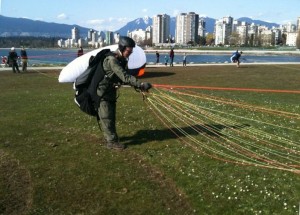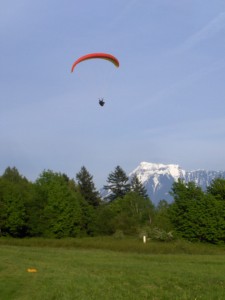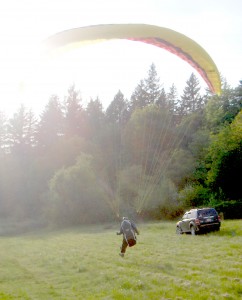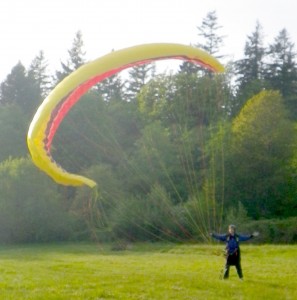05.22.11
Novice paragliding
Note: Dion, my instructor read this and was concerned that it painted an overly negative, overly scary picture of the sport. I toned my language down slightly, but my main objective was to tell my family and friends about how I felt, not to evangelize for how fun (or safe) the sport is!. Paragliding is actually quite safe when done right; my next post will be on paragliding safety.
My husband Jim flies powered aircraft; I find flying in small planes dull, noisy, cold, and a waste of fossil fuel. Jim sings; I don’t. Jim runs; I have bad knees. I do artwork; Jim doesn’t. I like to skate; Jim doesn’t. I like to read and write, which are inherently solitary activities. From time to time, one of us will try to do something that the other likes: I sang in one opera; Jim has gone skating a few times; Jim and I took a sketching class together; I have flown in small planes with Jim a few times. Unfortunately, those efforts have not worked really well. (For example, I threw up on one of my small plane rides with Jim.) Despite us really liking each other, we don’t do much together.
When we were in Turkey with the nephews, I got a chance to take a ride in a tandem paraglider. Despite throwing up twice due to motion sickness (I am sensitive, and didn’t take meds in time), it was one of the high points of the trip for me. (Figuratively as well as literally.) So I seized on paragliding as something we could maybe enjoy together.
We signed up for and are now mostly done with the P1 introductory class at iParaglide. In the rest of this post, I’m going to talk about our experiences.
We started out with two theory classes. We learned intellectually what we were supposed to do on launch and landing, about the gear, a little on the aerodynamics of the wings, how the controls affected the wing, how wind strength and weight affected ground speed and sink rate (which are the components of the glide ratio), and a bit about weather in BC.
We next had a gratis session of kiting practice. (This wasn’t on the class agenda, but Dion Vuk, our instructor, said that the weather was great for it and it would make us better fliers.) Kiting is done on a flat piece of ground and the exercise is to get the glider (aka “the wing”) aloft over our heads for as long as we could.
It was difficult, and hard work for my out-of-shape 47 year-old body. I was exhausted at the end of it. I said to myself that my enjoyment of this sport would be lower if I didn’t get myself into better shape, so I started carrying water in my backpack on my walk to work. Four or five days per week, I would walk 3km to work carrying five litres of water in my backpack; two or three days per week I would also walk home with it. If there had been an earthquake, I would have been prepared!
The day after our kiting session, the class of about seven students practiced what is called “slope soaring”. We got up at 5 AM to go out to a city park about an hour away which has about a 30′ hill. That hill is just steep enough that you can launch off of it, but not steep enough that you can get very high above it.
The wing needs a relative airspeed of 20 km/hr (12.5 mph, or 4:48 minutes per mile). This would be really really hard on a flat surface with no headwind if your name isn’t Usain Bolt, but running downhill with a little bit of a headwind (which drops the groundspeed you have to achieve) makes it more possible. It is still a little bit of a challenge: when the wing isn’t fully up, it’s like you are pulling a parachute — because you are! As soon as the wing gets up, it is easier, but if you don’t haul posterior, worst case the wing’s momentum can bring it over and in front of you and you run into the wing, oops. More likely is that you run run run and just don’t get enough speed to lift off the ground, which is unsatisfying.
There is no jumping: if you jump up, that reduces your airspeed and you just come right back down. (Hubby Jim also points out that it reduces tension in the lines, which is counterproductive: the tension in the lines is part of what gives it the shape you need.)
The weather that day was suboptimal: the winds were coming from the west instead of the east, which meant we needed to launch from a less-optimal hill; it was a bit gusty, so hard to keep the wing from rolling off to one side. Because the weather was worse than forecast, Dion decided to not take us up to the mountain that same day, but to give us another morning of slope soaring. I was glad, because I was wiped out. (See above about being 47 years old.)
Thus the next day, we got up at 5 AM to get to the park at 6 AM, for another three hours or so of slope soaring. It was much easier due to much better winds, and we had fun running up and down the hill in a friendly competition to see whic pair of people could get the most flights-with-air in a specified time. (Note: it is really helpful to have a “buddy” when learning. Once you are clipped in to your harness, you are connected to your wing so can’t do a good job of laying the wing out by hand if the wind moves it. We were taught how to better adjust our wing on the ground using our lines, but it is helpful to have an extra pair of hands. We were paired with a buddy in kiting and slope soaring.)
We then drove 2 hrs up to the mountain site, walked around the Landing Zone (LZ), and then went to lunch. The weather in the Lower Mainland of BC is such that almost always, the winds will pick up significantly at mid-day, too much for novices to handle. We pretty much can’t fly between 1300h and 1700h, so lunch tends to be from 1400h-1600h or so (with the rest of the time spent packing or unpacking and getting up from or down to the restaurant).
After lunch, Dion (slowly and deliberately) launched the students, one by one. The winds died down as the day progressed, so Dion launched the students in reverse order of weight, which put me in the penultimate spot.
A note: I ? Dion. Dion is extremely safety conscious, attentive, and supportive. Not only did he give Jim and I kiting practice plus two days of slope soaring practice before the Big Launch, he spent a long time with each student on launch to make sure that they had a good launch: checking the lines (the cables that attach to the glider), checking our harness (the thing that attaches us to the lines), laying out the glider so that it would be maximally easy to launch, reassuring us, etc. All of Dion’s students had perfect launches the first time that day; this was not true of all the student pilots with other teachers.
I had a totally unremarkable launch and then… I was in the air! “Was it cool? Were you excited?” I hear you ask. Well, yes and no. Mostly I was focusing on not killing myself; following Dion’s instructions on the radios (we each had radios clipped to our harness; two for redundancy) to sit back in the harness, do a left turn, a right turn, a 180, etc. as he made sure that I had some modicum of competency. Next, I was focusing on aiming at my target: three tall trees at the far, upwind side of the LZ. I was distracted for a minute by some bumps in the ride: I apparently had gone through a thermal: one bump for going in, one bump for coming out.
The landing sequence goes like this: go to above the far, upwind corner of the LZ (a rectangular grassy field bounded by tall trees). Do one or more figure-8s along the short side (cross wind) to burn altitude; then turn and go downwind along the long axis of the field on the far (i.e. farther from the launch area) side of the field. At the other end of the field (“the base”), optionally burn some more altitude with one or more figure-8s; turn into the wind (to help slow the groundspeed); at the last minute, flare (i.e. stall the wing) to give a slight bit of lift and a lot of decrease in ground speed; run like hell to keep up with the glider as it comes down.
We were told to always always always turn towards the instructor, never ever away (which meant left turns for this landing spot); to “put our landing gear down” (i.e. stand up in the harness instead of sitting in it) halfway down the downwind leg; and to never ever ever make sharp turns close to the ground. I blew all three of those. The LZ instructor (who was new) had the practice of putting legs down much closer to the touchdown so didn’t tell me yet, and I didn’t remember to do it on my own. On the downwind leg, I misunderstood the LZ instructor telling me to ease up on my right brake as a request for a right turn, which confused me long enough that I didn’t turn left when I should have. That meant that I was closer to the trees in front of me than I liked, so I made a sharp turn (oops!) to the left.
Well. If you do sharp turns, you lose altitude fast, and suddenly I was on the ground. Also, because I had not turned in time to hit the nice part of the field, I landed in bunch of briars. I didn’t really panic because I didn’t have time. One minute I was heading for the trees, the next I knew the ground was really close, the next I was on the ground on my side in the midst of briars.
I thought to myself, “Am I damaged? Nope: successful landing!” And I really wasn’t: not a cut, not a scratch. Later I found what might have been two tiny little puncture wounds, each about the size of a small zit, but I might have easily gotten those during slope soaring.
My stomach felt awful, however. My stomach is already acid-sensitive, and it turns out that adrenaline dumps a lot of acid into the stomach. I didn’t know that, however, so thought I had gotten motion sick. “This sucks!”, I thought to myself. I really wanted this to be something Jim and I could do together, but if I am so sensitive that I will get this motion sick on my first fifteen-minute flight, that wasn’t good.
Given how concerned everyone else was by my well-being after “crash landing” in the briars, and how bad I felt, they let me lie around groaning while they untangled my wing from the briars for me. Thanks, peeps!
Interestingly, this landing did not make me more scared of flying, it made me less scared. I am an out-of-shape, not particularly coordinated 47-year-old who did three things that I had been explicitly warned not to do, had an uncontrolled landing into briars, and still was unscratched. There is more room for error in this sport than I had realized.
Jim and I debriefed, went home, and collapsed into bed. I was wiped out.
The next two weekends had nasty weather, so we didn’t fly.
Finally, a break in the weather. On Thursday, Dion offered another evening kiting session that we jumped on. (The kiting sessions are surprisingly fun.) While I had trouble getting the wing up, I was not completely exhausted. Let’s hear it for carrying five litres of water 3 km to work and back for three weeks!
We were scheduled to have class on Sat/Sun, but Thursday evening, after the kiting session, Dion looked at the weather and didn’t like what he saw. He called around to see who could come to a session on Friday, and managed to get a quorum. So we got up at 5AM on a Friday morning and drove out to the mountain.
One really big advantage of flying on Friday is that we had almost no company at the top of the mountain. I think there were only five other people there the whole day.
On my first flight of the day, I was a little bit more relaxed, and actually got to look around a little bit. However, I came in a little bit low and wasn’t able to make my turn onto final. Instead, I landed crosswind on the downwind short-side of the field. This meant that I didn’t get any help from a headwind to slow me down. I couldn’t run fast enough, so stumbled and fell face-first.
The great news was that I was again completely unhurt (again, not even a scratch, bruise, or scrape); the good news is that my stomach wasn’t nearly as upset as it had been after my close encounter with the briars; the bad news is that my stomach was still unhappy; the worse news is that I got motion sick on the bumpy drive up the rutted logging road. (The great news is that I did not get vomit all over the inside of Jeff’s vehicle!)
I was still feeling queasy when the time came for my next flight. Dion asked how I was feeling, I shook my head “no”, and he immediately scrubbed my flight with no recriminations of any kind. The man is extremely supportive.
(Jim and the other students flew, however, and had great fun. Dion had them ride thermals a little bit to get them used to soaring. One of the other students, Jeff, is really good at this, in part from experience kiteboarding, and he was aloft forrrreevvvvvverrrrr!)
Then we debriefed, had lunch, and went back up. We started flying again around 1700h, I believe. As I said before, the winds are high mid-day and get weaker, so Dion again sorted by decreasing weight, putting me at the end of the line. When it was just me and Dion at the top, the wind started being a bit erratic and I started getting nervous about the launch. I was also aware that everyone else was waiting for me at the bottom. Dion soothed me and calmed me down about the launch.
I was also a bit nervous about the landing. The stated objective of the last flight was to get us to land on our own. At this point, I have one landing in the briars and one near-face-plant… and that was with help. Zero fully correct landings (unlike the others, who have had two or three apiece by this time). Now I’m supposed to do it on my own?
But Dion was right, the winds did die down. I tried to launch — and wasn’t going fast enough. I tried to abort, fell on my butt, and slid into my wing. Pick up, try again, wait… wait… wait… and finally, it was a go! I ran like hell down the slope and was airborne!
This time, everything felt smoother. I looked around more, and got to go “wow, I am way up in the air and can see all kinds of stuff!”. Eventually I got over the landing field and started my way down. First mistake: I did triangles instead of figure-8s to kill altitude on the upwind short side. No real harm done, but it meant that I ended up way over (inside) the field instead of sticking to the boundary. Next mistake: I forgot to put my landing gear down halfway through the downwind leg. Then, when I got to the base (downwind, short-side), I was a bit high.

On the base (downwind, short-side) leg
I did one loop of a figure 8 to kill some height, and started back towards the far side of the field. I dithered and dithered for an eternity (like, two seconds) about whether I should turn upwind or do another loop. I wasn’t sure if I had enough height to do another loop of the figure 8 or not, but felt like I was higher than I was supposed to be to land. I worried that if I was too low, then things would happen so quickly that the instructor (monitoring and on the radio to provide corrections if I got into trouble) might not be able to help me before I got in the trees, and that would be bad. The landing field is very long, so I figured that the instructor would have enough time to tell me how to recover if I was too high. I thus decided to go for “final” instead of another figure 8 loop.
I was too high to land in the first third of the field like they like us to. The orange spot in the lower left of the next photo is the target we were supposed to try to hit, and you can see I am way too high to hit that:
As I came in, I flew over the heads of the other students, who gaped up at me. It became clear that I was in fact going to land well before the trees, which was a relief. The LZ instructor came on the radio and told me to put my landing gear down when I was about 30 feet off the ground, oops! Fortunately, it was easy to pop into a “starfish” stance from my sitting position.
But where should I flare? If you flare too high, then you fall from a height. If you flare too low, then you don’t lose enough speed and might get pulled by your glider (i.e. face plant). Fortunately, the instructor came on and told me to when to flare. I flared hard and got ready to run like the dickens:
I touched down very gently, took two, maybe three dainty little steps, and was, much to my surprise, stopped! Zero forward velocity, and my wing was just sitting above my head. It took 15 or 30 seconds to float to the ground as I just stood there with my mouth hanging open. In the following picture, I am not only stopped dead, I have started to turn around an look behind me at everybody else. You can if you look very closely that the lines to the right of me are slack and starting to collapse.
It was amazing. I literally could not have imagined — it was beyond my imagination — that it was possible for me to have a landing like that.
My stomach was not upset immediately, but it got unhappy a minute or two later. (Not as bad as the other times.) I immediately chewed two Tums, and that seemed to make it better.
We debriefed and went home. The next day, I was really lethargic and spent basically the whole day in bed. Note, however, that I was merely lethargic after one day of flying plus one evening of kiting (and two days of getting up way way early) instead of being totally wiped out after one day of either. Now if you will excuse me, I need to go carry six litres of water down to the beach!













Jason said,
May 22, 2011 at 10:42 pm
Cool stuff!
Calvin said,
February 18, 2012 at 2:19 am
Really nice write up Kaitlin.
I’m considering doing the course and unfortunately suffer from really bad motion sickness. Am researching to see if and how big a problem that could be.
Cal.